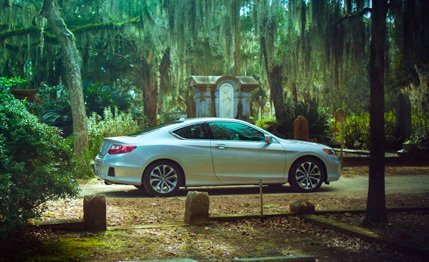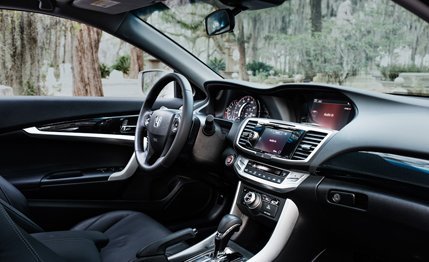
 Instrumented Test
Instrumented Test


Assumptions fly with the arrival of a driver in a two-door coupe: The driver has no young children. The driver pays others to deliver the new furniture and television sets. The driver does not spend long weekends at the lake, or shop for an orphanage at Costco, or rebuild old Mopars, or venture into rainy nights to walk a malamute.
Of course, you can own the new Honda Accord coupe while defying all of these assumptions, except maybe the one about the dog. But because people tend to buy cars they believe mesh perfectly with their busy lifestyles, rather than ones that might just do in a pinch, former rivals to the Accord coupe have steadily become stuffed pelts in the museum of automotive evolution.
The Toyota Camry Solara is gone, as is the Chevy Monte Carlo, and the Nissan Altima coupe is making death rattles. To make comparisons, we had to cast the net widely, from the Ford Mustang to the Volkswagen Beetle Turbo. Proof that it’s been a while since a two-door hardtop was urban chic lies in the increasingly vast flotillas of SUVs, of jacked-up Benzes and Hyundais shaped like hiking boots. In our auto biosphere, the elephants are winning.


Thus, what you see here is a survivor, albeit one expertly tailored in the Honda way to serve those with lesser lug-about needs. Whistling past the graves of others, the two-door Accord comes fitted with a four-cylinder or a V-6, and here we sample the latter, oddly equipped with the six-speed automatic. “Oddly,” we say, because a six-speed manual is also available with the 278-hp V-6, and our preference for sticks is well documented. But so is the wider population’s disdain for them, so we have, in this case for the sake of broader science, deigned to test Honda’s new automatic.
Choosing the V-6/automatic propels you out of the $20,000s and into the low-$30,000 realm, a sort of Mongolian desert for two doors. The only other kindred soul slogging its way across this barren stretch is the Hyundai Genesis Coupe 3.8. The Mustang V-6 and Beetle Turbo remain back in Mid-20s Town, and in the far distance is an oasis of pedigreed sports coupes such as the Audi A5 and Infiniti G37, which start at or just under $41,000.
Yet, when it’s all broken down into lease payments, this gussied-up Accord coupe sits a little too close to machines of seriously upscale pretensions to completely discount them as competition. The Honda is tangibly cheaper, but at $33,140 with the $2000 optional navigation system, it has to be the luxurious and dynamic real deal, or potential buyers might stretch to the next rung.


The coupe’s styling makes a strong start at keeping buyers in the Honda showroom. This is a company that doesn’t follow the crowd in mixing its genres. Whereas the new Accord sedan is something of a revival of flatter-roof, larger-window, more-upright-windshield practicality in a market hastening toward four-door Lotus Esprits, the coupe is definitely a coupe. From an unapologetically three-box profile, the coupe melts down and puddles rearward into a pleasingly sloped wedge. It breaks the air with an upturned bank of narrow headlights fanning out from the grille, and follows through with flexed tendons in the sheetmetal running up the sides to the rear. Black cutouts in the bumpers add a whiff of racy air ducting, but in fact are just blanked-off, design-studio theater. Because the new, smaller Accord heralds the industry’s retreat to more sane dimensions in this class, the robotic-snowflake wheels manage to look big even at just 18 inches.
As with any coupe, the doors are longer and may require foam bumpers to be deployed in the garage, but the inner armrests and pockets are at least slimmed down for easier exits. Honda’s cockpit-design ethos has swayed little with the winds of time, remaining primarily dependent on yards of black plastic interstitched with stacked tiers speckled with buttons. One large super-knob, familiar to any driver of a higher-spec Honda or an Acura of the past 10 years, controls the upper information screen.
What’s new is a second, smaller touch screen below, part of the EX and EX-L trim upgrades, that serves as the virtual radio console. This second screen is where the ergonomics turn silly. Its pixelated station-seeking buttons are a distraction to tap while driving, and the single, free-standing volume knob, while welcome, is needlessly lonely. By fitting a second knob for spin-tuning (the available real estate is ample and rotary car-radio knobs have been a winning design since the 1930s), Honda would have made the radio much easier to use. Note that you can’t buy any V-6 coupe without getting the touch screen.